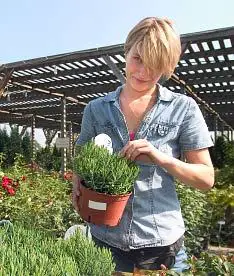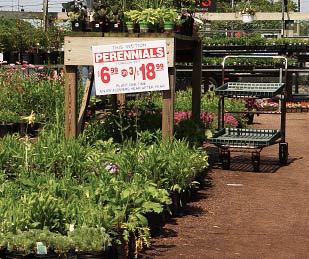Buying plants for your garden can be an overwhelming experience if you’re just learning to tell Echinacea (coneflower) from Echinops (globe thistle).
It helps to have a list so you are less likely to come home with impulse buys for which you don’t have the space or the right growing conditions.
Choose a well-run garden center

Examine plants carefully before buying
You’ll find plants sold in many different places from small garden centres to grocery store parking lots, home centers to big box stores.
Steer clear of temporary plant stands that sprout like crabgrass each spring. Yes, you can scoop up deals, but generally the selection is skimpy, the staff not well trained, and the plants not watered often enough.
If you discover a problem with a plant later on, the temp garden centre is long gone. You will pay a little more at a well-run garden centre, but you will find more selection, plants that are better cared for and more helpful staff.
When buying plants, look for these signs of quality in a garden center:
- A good selection of well-maintained plants arranged logically; for example, perennials for different conditions, such as sun or shade, displayed together in groups
- Labels showing plants in bloom, how-to-grow information, and expected size and spread
- Nursery wagons or carts to hold your purchases while you shop and aisles wide enough to maneuver them easily
- Knowledgeable staff who can answer gardening questions, make suggestions, or who will take the time to find someone who can
- Display gardens are a bonus – inspiring garden centres often showcase choice perennials in demonstration gardens, not just in pots.
Buying plants – bigger is better

Perennials in one-gallon size pots are a good buy
With annuals, it’s fine to buy small ones – these plants grow to maturity very quickly – but with perennials, bigger is better.
Often new gardeners opt for perennials in small 4-inch pots because they’re not confident they will be successful.
The reasoning goes: “If the plants die, I haven’t lost as much.”
But buying plants in tiny pots can be a misplaced saving because the smaller the plants, the more time you’ll have to spend nurturing them. You’ll have to watch that faster-growing plants or weeds don’t overpower them, that they don’t dry out, and that you don’t pull them out by mistake.
There’s a time-versus-money tradeoff: the smaller cheaper perennials will cost you more in time and care, and you’ll be waiting longer for them to grow and flower. I tend to buy perennials in one-gallon pots, as this size delivers a good growth in the garden quite quickly, but I rarely find it necessary to spring for the more expensive two-gallon size.
When buying plants, look for:
- Balanced, healthy looking growth and well-colored leaves.
- Avoid yellowed leaves (unless they’re supposed to be yellow); browned, stunted, or slimy leaves are signs of insect, wilting, frost or disease damage. Abundant new growth indicates a vigorous plant.
- Healthy roots: If you can do so without damaging the plant, pop it out of its container and look at the roots. Are they root-bound – strangled mass of roots circling around and virtually no potting soil visible, or is there a good proportion of soil to roots?
- Soil surfaces covered with weeds or moss usually indicate the plant has been in the same container a long time and may be pot-bound. Such plants will often struggle to get established in your garden.
Buying plants – colour sells
When buying plants, gardeners make a beeline to flowers in bloom. Of course, seeing the blooms is handy: it’s easier to decide whether a plant fits your color scheme.
However, many perennials for sale in spring are coaxed into early blooming in greenhouses before they would normally bloom in the garden. The next season, your perennial will bloom at the normal time for the species, which is usually a bit later. The normal time for blooming should be indicated on the plant tag.
Personally when I have a choice between a perennial in full bloom or one that’s just beginning to bud, I pick the latter: I want it to bloom in my garden, not at the store.
Beat the rush hour
The busiest time at any garden centre is a sunny weekend in May. Buying plants during the May holiday weekend can be overwhelming for novice gardeners, as garden centres are at their most crowded then.
If you need to take your time and ask for advice, go at off times: during the work week, early or late in the day, during the dinner hour or try a cool, rainy day when you can’t work in the garden.
Related information
Buying garden tools – look for quality








